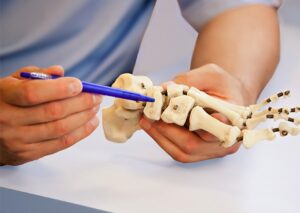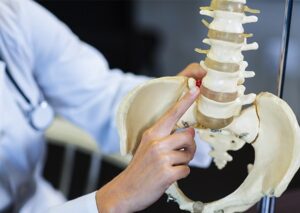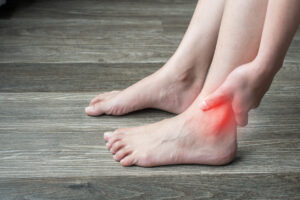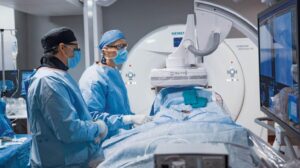Symptoms, Causes & Treatment of Leg Pain
Causes of Leg Pain
What causes leg pain and how can you find relief? The answer depends on the underlying condition that creates your symptoms.
Chronic or severe leg pain can be caused by a number of common conditions, such as:
- Intense exercise or overuse (muscle aches)
- Blood clot (deep vein thrombosis) or peripheral artery disease
- Injury
- Muscle, ligament or tendon strains
- Fibromyalgia
- Skeletal structure irregularities
- Arthritis
- Poor circulation or cardiac disorders
- Nerve damage
- Herniated disc or other lower spine condition
- Sciatica from spinal disc disease
- Diabetic neuropathy
- Osteoporosis
- Other underlying conditions

Leg Pain Symptoms and Diagnosis
Be sure to inform your doctor of all your symptoms. Some symptoms of leg pain can include:
- Pain in one or both legs, with or without back pain
- Foot pain
- Pain that comes on suddenly or comes and goes
- Redness or discoloration of the skin on the leg
- Swelling in the leg, ankle or calf
- Distended veins
- Weakness
- Leg skin that is warm to the touch
- Itching or throbbing skin
- Pain that worsens when walking or exercising
- Sciatica leg pain or pain that radiates down the back of the leg toward the feet
- General leg stiffness or morning stiffness
- Numbness, tingling or throbbing
- Muscle pain / muscle aches
- Aching with or without fever
- Tenderness
- Burning pain
- Reduced range of motion
- Change in how you walk or move due to pain (limping)
- Muscle cramps
- Achilles pain in your lower calf
Be sure to get medical help right away if you have trouble breathing, dizziness or chest pain along with leg discomfort, as this could be a sign of a blood clot.
To diagnose the cause of your pain, your doctor will ask you questions about your health and family history, and do a physical examination. Other tests that can help diagnose the source of your pain include X-rays, MRI scan, CT scan and blood tests. It is important that your condition is properly diagnosed so that you can receive the most effective and appropriate treatment.

How to Treat Back Pain
How can you ease the discomfort of leg pain? Your treatment options depend on the underlying cause and severity of your leg pain.
Treatment may start with conservative therapies, such as over-the-counter aspirin, acetaminophen or ibuprofen. These nonprescription medications can be effective for certain types of leg pain when taken according to instructions.
You may also consider home care such as drinking plenty of water to reduce leg cramps. Stretching and massage can also help. You may also try using heating or cold packs, taking warm baths or showers, and resting your legs. Be sure to wear shoes that support the arch in your foot and are comfortable to wear. Elevate your leg when you sit or lie down.
The pain management specialists at The Total Pain Clinic may also recommend the following interventional pain therapies to reduce your leg pain:
- Prescription medications / medication management
- Topical agents (creams)
- Injections such as steroid medications
- Spinal cord stimulation
- Nerve blocks
- Biofeedback
- Physical therapy (can include exercises, losing weight if necessary, heat and cold therapy, electrical nerve stimulation)
- Alternative treatments such as acupuncture, chiropractic adjustments and/or massage
Some of the interventional medical therapies we provide at The Total Pain Clinic include:
The pain specialist will prescribe and regulate the medication that you use to help control your pain. The pain management specialist will provide you with the knowledge you need to take your medications properly.
The Total Pain Clinic takes a conservative approach with medication management. We try to limit prescription medications to help avoid dependence.
One option for treating pain is injections of dexamethasone, a steroid that helps reduce pain and inflammation. This can be very effective for arthritis, rheumatoid arthritis and osteoarthritis.
A nerve block is an injection therapy that reduces pain caused by a nerve(s). This can help treat peripheral neuropathy, diabetic peripheral neuropathy and neuropathic pain. This procedure injects a combination of local anesthetic agents around the peripheral nerve branches for optimal pain relief. Peripheral nerve blocks may provide relief that lasts from a few weeks to a few months, depending on the patient’s condition.
Spinal cord stimulation is an FDA-approved, minimally invasive procedure that requires the implantation of a nerve stimulation device. This treatment delivers low-voltage electrical currents to areas of the spine, ultimately reducing pain signals caused by chronic pain. Patients living with chronic back or leg pain, who have not responded to conservative treatments for at least six months, may be candidates for this procedure. A trial device is implanted before a permanent device is considered.
Contact The Total Pain Clinic today to learn more about how we can help you effectively manage your leg pain.

When further leg pain treatment is required
Based on the underlying condition, further treatments may be required. If there is something that can be addressed by another type of specialist, we will refer you to the appropriate specialty doctor.




















